Advanced Technology Program Shaping the Nation’s Future Technologies
Advanced Technology Program Shaping the Nation’s Future Technologies. ATP 2004 Proposers’ Conferences. National Institute of Standards and Technology Technology Administration U.S. Department of Commerce. Today’s Program. ATP Overview Competition Process Business Criterion
Share Presentation
Embed Code
Link
Download Presentation
- atp
- economic benefits
- commercialization plan
- intellectual property
- economic benefits cont
- broad based economic benefits

vernon-reese + Follow
Download Presentation
Advanced Technology Program Shaping the Nation’s Future Technologies
An Image/Link below is provided (as is) to download presentation Download Policy: Content on the Website is provided to you AS IS for your information and personal use and may not be sold / licensed / shared on other websites without getting consent from its author. Content is provided to you AS IS for your information and personal use only. Download presentation by click this link. While downloading, if for some reason you are not able to download a presentation, the publisher may have deleted the file from their server. During download, if you can't get a presentation, the file might be deleted by the publisher.
Presentation Transcript
- Advanced Technology ProgramShaping the Nation’s Future Technologies ATP 2004 Proposers’ Conferences National Institute of Standards and Technology Technology Administration U.S. Department of Commerce
- Today’s Program • ATP Overview • Competition Process • Business Criterion • Technical Criterion • Gated Approach and Electronic Submission • Administrative Highlights • Closing Remarks
- ATP’s Mission … To accelerate the development of innovative technologiesfor broad national benefit through partnershipswith the private sector.
- 900 mm 33 mm Exciting New Technologies … Bridging the Gap Between the Laboratory and the Marketplace
- ATP is Part of NIST NIST’s Mission …Strengthen the U.S. economy and improve the quality of life by working with industry to develop and apply technology, measurements, and standards. $773 million FY 2004 operating budget 3,000 employees 1,800 associates NIST laboratories: National measurement standards Advanced Technology Program: $2,114 million co-funding with industry since 1990 Manufacturing Extension Partnership:400 centers nationwide to help small manufacturers Baldrige National Quality Award Helping America Measure Up
- Since 1990 … • 6,054 proposals submitted to 43 competitions, requesting $12,969 M from ATP • 709 projects awarded with 1,433 participants and an equal number of subcontractors • 207 joint ventures and 502 single companies • $4,101 M of high-risk research funded • ATP share = $2,114 M • Industry share = $1,987 M • Small businesses are thriving • 65% of projects led by small businesses • Over … • 165universities participate • 30national laboratories participate • 900 patents
- 709 ATP Awards by Technology Area(As a Percent of $2,114 M Awarded) Forty Three Competitions (1990 – September 2003)
- Distribution of Company SizeLead Companies709 ATP Awards Forty Three Competitions (1990 – September 2003)
- MA RI CT NJ DE MD DC AK U.S. Virgin Islands HI Puerto Rico Number of Applications (6,054 total) Number of Awards (709 total) Number of Participating Organizations (1,433 total) State Participation in ATP to Date … * Geographic location is not a consideration in project selection. The ATP has an active outreach program that seeks to increase awareness across the entire nation of the program's opportunities for small, medium, and large businesses and other organizations. To date, ATP has received applications from organizations based in every state, and has provided funding to participating organizations located in 45 states, and the District of Columbia.
- What Can ATPDofor You? • Create sustainable technical advantage • you direct the research goals • we share in the risk of longer-range, higher-payoff research • ATP commits ~ $1,000,000 per year per project • Retain your Intellectual Property Rights • U.S. for-profit companies keep rights to intellectual property from ATP-funded projects • Encourage integration of business and technical planning • plan now for commercializing your research results • attend ATP-sponsored workshops with venture capitalists
- What Can ATP Do for You?(cont’d) • Gain recognition within industrial and financial sectors • an ATP award will attract attention from investors, strategic partners, potential customers, and others • Find partners through our website • visit ATP’s Collaboration Bulletin Board • join ATP’s Alliance Network List Server • We are flexible and fair, but firm • we will monitor your progress, but also be supportive if roadblocks appear as long as the project continues to meet the criteria
- Is ATP Right for You? • Are you looking to further your technical advantage by conducting challenging research? • Are the risks primarily technical? • Does your project have the potential to generate broad-based economic benefits for the United States? • Are you committed to taking the research into the marketplace?
- For-profit company 3-year time limit $2M award cap Company pays indirect costs Large companies cost share at least 60% of total project costs Alone With Subcontractors Company Company Company University Research Lab TwoWaysto Apply … As a Single Company: ATP encourages teaming arrangements Most projects involve alliances
- At least 2 for-profit companies 5-year time limit No limit on award amount (other than availability of funds) Industry share >50% total cost As a Joint Venture: Formal Alliances With Subcontractors Company + University Company Consortium Company Research Lab Research Lab University Company TwoWaysto Apply …(cont’d) ATP encourages teaming arrangements Most projects involve alliances
- Two Major Criteria • Scientific and Technological Merit (50%) • Technical innovation • High technical risk with evidence of feasibility • Detailed technical plan • Potential for Broad-Based Economic Benefits (50%) • National economic benefits • Need for ATP funding • Pathway to economic benefits
- PROPOSALS SCREENING CLASSIFICATION Gate 1: FULL TECHNICAL PLAN + PRELIMINARY ECON/BUS PLAN SCIENTIFIC & TECHNOLOGICAL MERIT ECONOMIC/BUSINESS MERIT • National Economic Benefits • Need for ATP Funding • Pathway to Economic Benefits • Technical Innovation • High Technical Risk with Evidence of Feasibility • Detailed R&D Plan Gate 2: FULL ECONOMIC/BUSINESS PROPOSAL + BUDGET NARRATIVE Gate 3: SEMIFINALISTS IDENTIFIED • Oral review Cooperative Agreement Gate 4: AWARD DEBRIEFING Project Selection Process
- The Gated Approach • Gate 1: Executive Summary, complete technical narrative, plus preliminary info on economic/business narrative • Gate 2: Complete economic/business narrative, plus detailed budget information, if pass gate 1 • Gate 3: Semifinalist, if pass gate 2 • Gate 4: Award, if pass gate 3 and selected
- Two Major Criteria • Scientific and Technological Merit (50%) • Technical innovation • High technical risk with evidence of feasibility • Detailed technical plan • Potential for Broad-Based Economic Benefits (50%) • National economic benefits • Need for ATP funding • Pathway to economic benefits
- What is Needed for Technical Success? What is Needed for Market Success? Business Drivers and Technical Planning Overcoming High Technical Risk Barriers Market Opportunity Technical Innovation
- Economic/Business Criterion • Potential for Broad-Based Economic Benefits • National economic benefits • Need for ATP funding • Pathway to economic benefits
- National Economic Benefits ATP Perspective ATP cares about longer term net benefits for the nation Private Investor Perspective Private investors care about near term and own return on their investment
- National Economic Benefits (cont’d) • Describe the business opportunity • Why is it of economic importance to you and the nation? • How will you benefit? How will others benefit (e.g., your customers, competitors, your industry, other industries, and the general public)? • What is the business advantage of your technical approach over others? • Quantify the magnitude of impact
- National Economic Benefits (cont’d) • Who are the potential users of the technology? • How large are the markets and what are the growth trends? • How will these markets change once the proposed technology is available? Be specific and give supportingevidence (quantitative and qualitative).
- Need for ATP Funding Describe the difference ATP can make Broader scale or scope of R&D? Acceleration of R&D? Greater collaboration? … leading to greater national benefits faster What market opportunity will be missed without ATP funding?
- I need money for R&D Need for ATP Funding(cont’d) Why does your project need public funds? • Is the project “too risky” to obtain private or internal funding? • Do you think your company won’t capture the major benefit? • Where else have you looked for funding and why you were unsuccessful? • Why ATP and not some other Federal Program? • Document past efforts to secure funding from private sources, government sources, industry partners Corporate Investment? Government? Venture Capital? Institutional Loans? Personal Sources? Angel Investors?
- Pathway to Economic Benefits Commercialization Pathways New/Improved Products, Processes, and Services ATP-Funded Projects Demonstrate an understanding of the market and the market need Assess your strengths, weaknesses and opportunities from a competitive standpoint Develop a commercialization plan Broad Based Economic Benefits
- Commercial- ization Plan and Strategy Intellectual Property Protection Broader Diffusion U.S. Economic Growth Business Experience and Qualifications CompanyCommitment, Structure & Management Organizational Information Pathway to Economic Benefits (cont’d) What is your strategy, plan, and project structure for realizing your own growth and for national economic benefits?
- Products and markets Window of opportunity Strategic vision Potential uses Resource planning Pricing and sales Company structure Competitive analysis Growth Strategy for bringing product to market Investment strategy Production and distribution Strategic alliances and early adopters Commercialization Plan Company Applications Taking Technology from the Laboratory to the Marketplace
- Commercialization Plan - Tips • Plan for commercialization at the outset and involve your business staff • Recognize that a fantastic technology may capture the imagination but not necessarily the market • Develop a reasonably well defined commercialization plan for the technology
- Intellectual Property Protectionand Broader Diffusion • How will you protect the core technology needed to commercialize the results? • How will benefits of your technology reach others? • How will new knowledge diffuse to others in the same or other industry sectors? • publish results? patent? seek licensing partners? include user groups? form alliances? • What will you do to increase likelihood of diffusion beyond project participants?
- Commitment • Company resources • human; financial; equipment; research facilities • Priority of project to the company • involve highest appropriate level of management • strong company role; not just pass-through to subcontractors • every JV partner has a clear role • Evidence of customer / supplier / investor interest and support • letters showing real interest and involvement • formal and informal alliances • other forms of active involvement
- Organizational Structure, Project Management, andBusiness Experience/Qualifications • Roles/responsibilities of participants • show qualified business personnel involved • Plan for managing project’s tasks • Business experience/track record of each company and its principals • Evidence of financial and business viability
- Organizational Information • Date and state of incorporation • Previous federal awards • Source of cost share • Financial, employment, and ownership information
- Lacks connection between technical goals and business opportunity Insufficient evidence of economic benefits Poorly developed or no commercialization plan Insufficient plan for broader diffusion Insufficient plan for including critical business partners Failure to address market opportunity Unconvincing case for the need for ATP funding Common Proposal Weaknesses: Business
- Summary: Economic/ Business Criterion • Preliminary info briefly addressing “potential for broad-based economic benefits” selection criterion (Gate 1) • Fully address “potential for broad-based economic benefits” selection criterion (Gate 2, if your technical plan passes Gate 1) • Single company: 4 pages maximum • Joint venture: 5 pages maximum • Single company: 15 pages maximum • Joint venture: 20 pages maximum
- What is Needed for Technical Success? What is Needed for Market Success? Business Drivers and Technical Planning Overcoming High Technical Risk Barriers Market Opportunity Technical Innovation
- Scientific and Technological Merit Criterion • Scientific and Technological Merit • Technical innovation • High technical risk with evidence of scientific feasibility • Detailed R&D plan
- Linking Innovation and Risk: Describe a Successful Leap Does your idea… • Extend the state-of-the-art? • Change the state of practice? • Integrate multi-disciplinary technologies? Path Changing R&D
- Technical Innovation Your New Technology What are the project’s objectives? What are the quantified targets? What innovations are needed? How will it compare to future competition? Technical Barriers to Overcome Baseline: State-of-the-Art Within the team? Within the industry at large?
- Technical Innovation(cont’d) • Define objectives and quantify targets for these objectives • Describe the technical barrier needing innovation • What is the problem? • Outline why the solution or approach is innovative—contrast concrete targets to current practice and your competition • What is “the gap” needing innovation? • Illustrate the technical impact with and without complete success • What will be the technical legacy of the innovation?
- High Technical Risk and Feasibility Feasibility sound scientificfoundation sound engineeringapproach High Technical Risk technical challenges significant uncertainty ofsuccess risky innovation orintegration High Technical Risk Feasibility Your ATP proposal should balance both!
- High Technical Risk With Evidence of Scientific Feasibility • Analyze the highest technical risk elements • What certain tasks are the most challenging and why? • Would the risks be credible to those in the field? • Provide evidence that the approach is feasible • Why are the scientific and engineering foundations sound?
- Detailed R&D Plan How will you achieve your goals? Tasks / Sub-tasks Contingency Plans Technical Resources Decision Strategy Multidisciplinary Team Milestones Gantt Chart Metrics Essential Elements of a Quality R&D Plan
- Detailed R&D Plan(cont’d) • Detailed description of technical approach • Tasks and subtasks described and linked to performer(s) • Interrelationships of tasks • Metrics—quantitative and objective • Milestones—interim and final • Decision-point strategy • Contingency plans/alternate approaches • Project timeline Gantt chart
- Technical Experience and Qualifications (Including Key Suppliers and Informal Collaborators) • Technical experience, qualifications and location of all technical performers, key suppliers, and informal collaborators • Subcontractors and key suppliers • Joint Venture partners • Critical Informal collaborators • Describe any ownership or financial arrangements between performers with any of the proposer(s) • Explain R&D at non-U.S. sites and see Exhibit 12
- Facilities and Resources • Adequacy of facilities, equipment and resources • Existing vs. needed • Timeline for meeting needs
- Human and Animal Subjects • ATP funds projects involving human and/ or animal subjects • Must comply with applicable Federal rules • Not limited to traditional biomedical research • Refer to “Guidelines and Documentation Requirements for Research Involving Human and Animal Subjects”
- Common Proposal Weaknesses: Technical • Lacks sufficient detail • How will you reach technical objectives? • What’s innovative? • Why is a risky technical approach needed? • Unsupported assertions • Outside ATP mission • Low risk (e.g., product development) • Lacks demonstrated feasibility (e.g., basic research) • Scale-up or demo to only prove economically feasible • Lacks connection between technical goals and business opportunity
- Summary: Scientific and Technological Merit Criterion Three critical components need to be addressed (Gate 1) • Technical innovation • High technical risk with evidence of scientific feasibility • Detailed R&D plan Single company: 20 pages maximum Joint venture: 30 pages maximum
- Summary: The Gated Approach • Gate 1: Complete technical narrative, plus preliminary info on economic/business criterion • If pass, go to Gate 2; otherwise debriefing • Gate 2: Full economic/business narrative, plus detailed budget information • If pass, go to Gate 3; otherwise debriefing • Gate 3: Semifinalist (oral review) • If pass, go to Gate 4; otherwise debriefing • Gate 4: Award, if pass gate 3 and selected Load More .

Next Generation Speech and Video: Support for Research in Advanced Speech Recognition Technologies John Garofolo IAD Spe
Next Generation Speech and Video: Support for Research in Advanced Speech Recognition Technologies John Garofolo IAD Speech Group Overview Directions in automatic speech recognition DARPA EARS Program NIST RT-02 Evaluation NIST Meeting Data Collection Project Our Vision of the Future
538 views • 17 slides
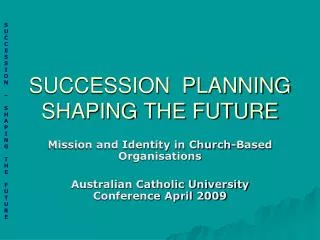
SUCCESSION PLANNING SHAPING THE FUTURE
SUCCESSION PLANNING SHAPING THE FUTURE. Mission and Identity in Church-Based Organisations Australian Catholic University Conference April 2009. Why we are here. If you are asking the question “How do we shape our future so that our endeavour is valid, sustainable and authentic?”
818 views • 61 slides

Technology fields and competences dr. Zoran Marinšek INEA d.o.o. Competence Centre for Advanced Process Control Technolo
New Energy Technologies and Process Control Technologies in Slovenia. Technology fields and competences dr. Zoran Marinšek INEA d.o.o. Competence Centre for Advanced Process Control Technologies. Structure of presentation. Process of selection of technologies : Long list of technologies
689 views • 50 slides

Outsourcing my Future?
Outsourcing my Future?. Marilena S. Carvalho, M.Eng. CONTEXT: Why Study Technology Overseas?. Globalization is a major force shaping the engineering profession Engineering 2000 criteria adopted by the Accreditation Board for Engineering and Technology (ABET)
509 views • 39 slides

Shaping a More Efficient Future Pricing Change Effective Monday, May 14
Shaping a More Efficient Future Pricing Change Effective Monday, May 14. Shaping a More Efficient Future New Prices. Reflect changes in operations and the marketplace Offer more choices Include incentives Reduce undeliverable-as-addressed mail Better reflect that shape matters.
334 views • 23 slides

Executive Session 04 Transportation and Climate Change—How Washington is Shaping Our Future Technology and Policy Perspe
Executive Session 04 Transportation and Climate Change—How Washington is Shaping Our Future Technology and Policy Perspectives on Sustainable Transportation. Robert L. Bertini, Ph.D., P.E., Deputy Administrator Acting Director, Intelligent Transportation Systems Joint Program Office
522 views • 37 slides

Shaping Our Future thru Collective Impact
Shaping Our Future thru Collective Impact. Educate to Lead. Shaping Our Future thru Collective Impact. Achieve the Soroptimist Mission Measure sustainable improvement I ncrease the socio-economic status Recognition Attract more resources. Shaping Our Future thru Collective Impact.
360 views • 13 slides

“Technology Education in Shaping a Sustainable Future”
“Technology Education in Shaping a Sustainable Future”.
195 views • 2 slides
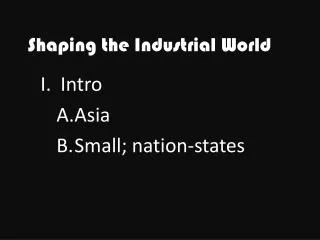
Shaping the Industrial World
Shaping the Industrial World . Intro Asia Small; nation-states. II. Emergence of Europe A. 1. expand 2. technology a. compass; long sea voyages b. gun powder B. 1. barter 2. money; invested C. 1. money 2. explore. III. The Industrial Revolution.
221 views • 12 slides

AEgis Technologies ’ SBIR/STTR Success Story Advanced Defense Technology Cluster
AEgis Technologies ’ SBIR/STTR Success Story Advanced Defense Technology Cluster AEgis Technologies Group SBIR Workshop 20 February 2013 Presented by Steve Hill President & CEO The AEgis Technologies Group, Inc. . SBIR/STTR Program Highlights.
347 views • 18 slides

COPS 2007 Technology Program Advanced Training Workshops
COPS 2007 Technology Program Advanced Training Workshops. Indiana: Interoperability Over the Long Haul A Plan that Survives Economic Crises and Technology Turmoil. David Smith Indiana Integrated Public Safety Commission. Project Hoosier SAFE-T is….
393 views • 21 slides

WORKSHOP E-4 SHAPING A NEW FUTURE FOR OUR PROGRAMS
WORKSHOP E-4 SHAPING A NEW FUTURE FOR OUR PROGRAMS. Today’s Topics: Our Workforce Who’s working for you? Who’s out there? The public, private sector picture A new look for the future The new workforce project. Graying of the American Workforce.
527 views • 35 slides

Innovative Technologies Contributing to Future Earth Science Capabilities
Innovative Technologies Contributing to Future Earth Science Capabilities Presented to: Working Group on Space-Based Lidar Winds June 17, 2009. George J. Komar Associate Director/Program Manager Earth Science Technology Office. Earth Science Division Overview.
238 views • 13 slides
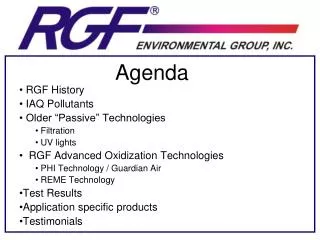
Agenda
Agenda. RGF History IAQ Pollutants Older “Passive” Technologies Filtration UV lights RGF Advanced Oxidization Technologies PHI Technology / Guardian Air REME Technology Test Results Application specific products Testimonials. RGF History. Founded in 1985
870 views • 55 slides
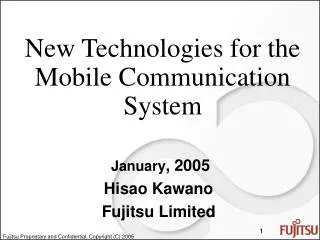
New Technologies for the Mobile Communication System
New Technologies for the Mobile Communication System. January , 2005 Hisao Kawano Fujitsu Limited. Contents. High Speed Down Link Packet Access(HSDPA ) Smart Antennas High-Efficiency Power Amplifier (HPA) Advanced Mobile Terminals Ubiquitous Wireless IP Phone Future Technology.
519 views • 36 slides

Radiology Grand Rounds University of Maryland Baltimore, MD February 1, 2006
Impact of Advanced Technologies Future of Medicine. on the. Richard M. Satava, MD FACS Professor of Surgery University of Washington Program Manager, Advanced Biomedical Technologies Defense Advanced Research Projects Agency (DARPA) and Special Assistant, Advance Medical Technologies
841 views • 63 slides

Shaping a New Nation
Shaping a New Nation. The United States after the Revolutionary War. F.O.A. ( Bellwork ). Essential Questions. What were the major successes and failures of the government under the Articles of Confederation? (8.4 spi 6)
748 views • 57 slides

Natural Gas Technologies For The Future Melanie Kenderdine Gas Technology Institute
Natural Gas Technologies For The Future Melanie Kenderdine Gas Technology Institute Energy and Nanotechnology: Strategy for the Future Houston, Texas May 2-4, 2003. Drivers for Natural Gas Demand. Resource Abundance Overall Growth in Energy Demand Geopolitics of Oil
557 views • 39 slides
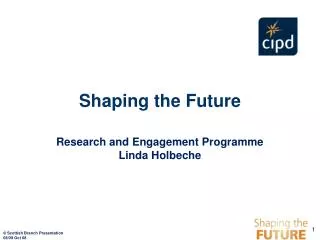
Shaping the Future
Shaping the Future. Research and Engagement Programme Linda Holbeche. Overview. History Programme How can you be involved? Questions. Not just conventional research…. Future-focused, geared to fast-changing context
429 views • 22 slides

Shaping an Abundant Land
Shaping an Abundant Land. Chapter 6. History and Government of the United States. Section 1. The United States is a “nation of immigrants,” settled by people from all over the world. The United States is the most diverse and highly industrialized and urbanized nation in the world. Main Ideas.
904 views • 67 slides

Advanced Technology Development Center (ATDC) Presentation to ASTWG
Advanced Technology Development Center (ATDC) Presentation to ASTWG. Presenter: Greg Clements ATDC Project Manager. ATDC Objective. The ATDC will provide the nation with a “World Class” facility for the research, development, demonstration, testing and qualification of Spaceport Technologies.
410 views • 27 slides























